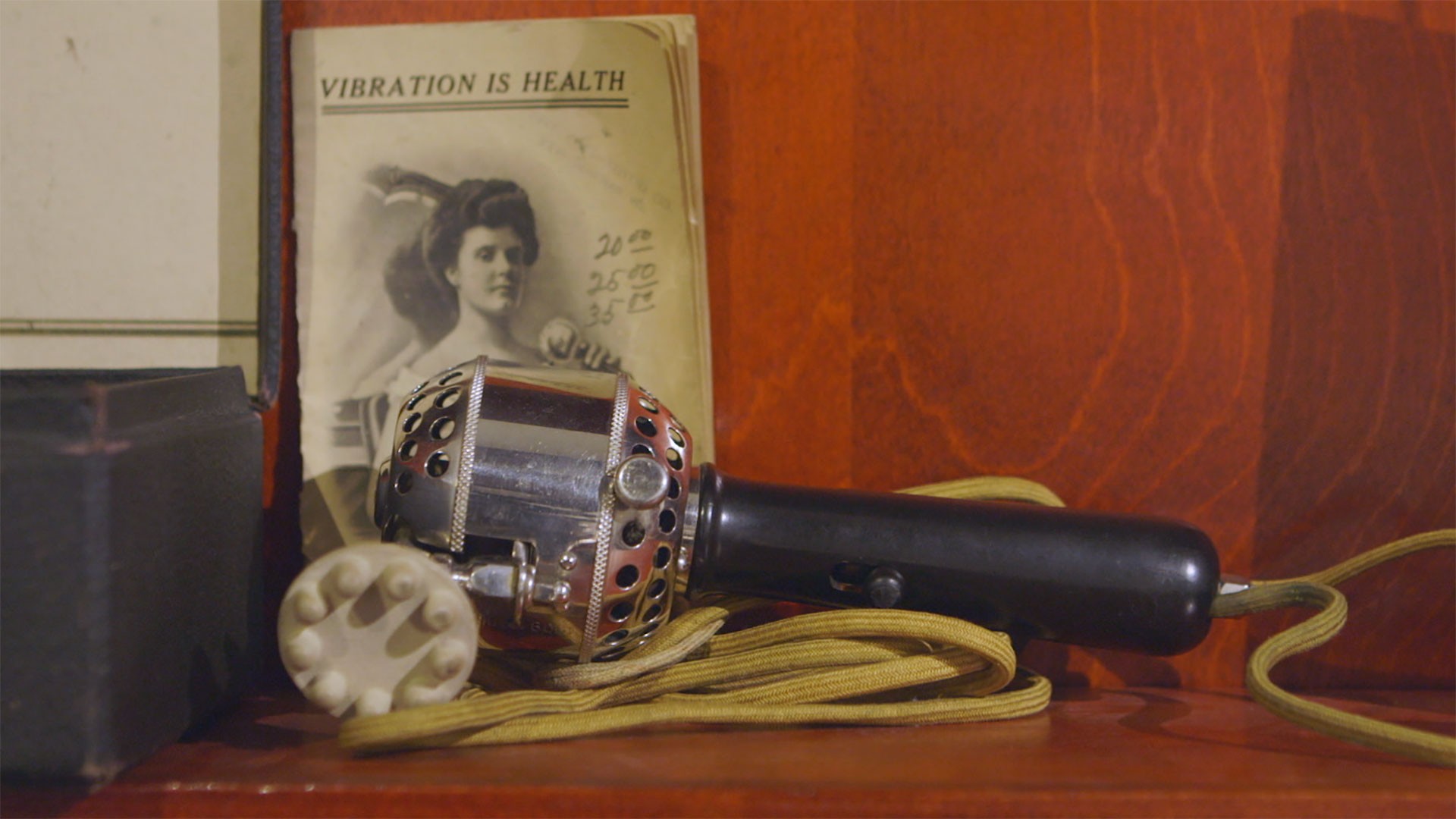"Worry less, communicate more," read the marketing materials for Revolar, a wearable panic button you can attach to a keychain or handbag. The device works by sharing your location with trusted contacts. Click Revolar once and you can check in—letting them know you're home from work safely, for example. Click twice, or three times, and you can request immediate assistance.A slick promotional video for the product shows a woman with a fashionable manicure attaching the sleek silver keychain to a designer handbag. Later another young woman in a denim shirt and Wayfarer-style sunglasses holds up a placard explaining she's scared of being another "statistic" when she goes to college in the fall. It's clear the device is being mainly marketed at women—four out of the five models in the video are female. But not everyone is impressed by Revolar's claims, or by the broader idea that you can buy your way to empowerment with a $60 wearable device.
Advertisement
"Nothing says 'empowered' more than wearing an attack button on one's person at all times," one user writes in an Amazon review entitled, "My Panic Button Makes Me Feel So Free." The messaging of this company couldn't be any more paradoxical and stupid," she goes on.
Watch: The History of the Vibrator
Such methods aren't ideal, for obvious reasons—philosophically, they put the onus on women to prevent rape, and more practically, they only work once you've actually been penetrated. A recent wave of technological innovations meant to prevent sexual violence have sought to intervene sooner, facilitating silent calls for help: In 2011, an app called "Circle of Six" was launched. When activated, it sends out a message to trusted contacts, asking them to intervene when the person feels unsafe in a given situation.
Anti-rape technologies aren't new; in fact, they're extremely old, arguably dating back to the chastity belts of the 15th century (though some historians debate argue the infamous device might have actually been a medieval joke). More recently, a slew of aggressive anti-rape products have been introduced around the world: One 1979 anti-rape device, worn internally, would inject tranquilizer fluid into the rapist, knocking them out. The Trap, invented in 1993, is a rubber pocket with plastic spears which, worn internally, is designed to clamp the head of a penis. In 2000, a retired South African doctor designed a "killer tampon," containing an embedded razor blade, to slice off an unwelcome penis.Read more: 'There Was a Stranger in My Own House': Is the Sharing Economy Safe for Women?
Watch: The History of the Vibrator

Such methods aren't ideal, for obvious reasons—philosophically, they put the onus on women to prevent rape, and more practically, they only work once you've actually been penetrated. A recent wave of technological innovations meant to prevent sexual violence have sought to intervene sooner, facilitating silent calls for help: In 2011, an app called "Circle of Six" was launched. When activated, it sends out a message to trusted contacts, asking them to intervene when the person feels unsafe in a given situation.
Advertisement
Circle of Six is in good company: the personal safety app space has grown as crowded as a swaying commuter train at rush hour. There's Watch Over Me, an app that tracks your activity—say while you're out jogging—then sends out an alert if you don't check in safely after completing the run. The Scream Alarm will shriek on your behalf at the touch of a button, or Panic Guard will cause your phone, when shaken, to turn on your alarm and video camera.
But, as critics note, these modern anti-rape apps and devices still present preventing rape as the victim's responsibility alone. This insidious attitude has made its way into numerous other well-meaning anti-rape innovations—in 2014, for instance, an all-male research team from North Carolina State University won funding to develop a nail polish, Undercover Colors, that would change color to indicate the presence of date-rape drugs in a drink. The following May, an anti-rape bracelet that releases a foul smell when the wearer is attacked won a corporate innovation award.Like Revolar, the roofie-detecting nail polish attracted immediate criticism. Not everyone was enthused by the prospect of using your pinkie as a swizzle stick, arguing that these technologies—which are usually created by men—reinforce the antiquated notion that women should modify their behavior to avoid rape. "How about women don't have to wear a special nail polish and dunk their fingers in every cocktail to not get raped?" asked writer and activist Lindy West. "This new nail polish that can detect the date rape drug is great if you think women aren't trying hard enough not to get raped," snarked author Kelly Oxford on Twitter."How about women don't have to wear a special nail polish and dunk their fingers in every cocktail to not get raped?"
Advertisement
Wear rape alarms, swirl your drink with your finger. Neither of these technologies innovates towards the obvious solution to ending sexual violence: discouraging rapists from committing acts of sexual assault, whether through education initiatives or by helping to catch and prosecute more rapists. And products like this reinforce the cultural idea that women are fundamentally unsafe and in need of protection, critics say."Revolar really feels like it's capitalizing on women's fear and promoting a false sense of safety," argues Dr. Fiona Vera-Gray, a sexual violence expert at the University of Durham. She points out that statistically, women are most likely to be raped by the people closest to us, not strangers on the street. "It reinforces the idea that women need to be afraid and buy into this thing so that men aren't a risk to us."Do wearable rape alarms reinforce a sexist, paternalistic culture that tells women they aren't safe to move around as they please? Or do they just recognise the shitty reality that many women feel unsafe in public spaces, and help to address that? Jacqueline Ros, Revolar's founder and CEO, who was inspired to set up Revolar after her sister was sexually assaulted as a teenager, would argue the latter. "I'm 120 percent behind education efforts [to reduce sexual violence]," she tells Broadly. But cultural change takes time, and she says she wants to help women feel more secure in the interim. "It's the combined power of technology and education. Every time you set someone up on Revolar, that's another person being educated on the fact their loved one lives in a world where they don't feel safe."
Advertisement
But what if there was a genuinely innovative way for technology to respond to sexual assault, one that went focused on prevention instead of reacting to isolated acts of violence? That's one of the animating ideas behind Callisto, a new desktop-app (it doesn't exist yet in mobile) that lets sexual violence survivors on college campuses create secure, time-stamped records of their assaults. From there, they're given three options. They can email the report to their school's Title IX coordinator, the person involved with overseeing sexual assault investigations. Or they can save the report and decide what to do with it at a later date (since the account is time-stamped, to make potential future investigations easier).The third option is the most groundbreaking. Users can have the option of putting their report into a "matching" category. "What matching does is enable survivors to enter their perpetrator's identity into the system, with the understanding that this information will only be released to the university if another Callisto user enters the same perpetrator," explains Project Callisto communications and marketing director Anna Kim.Say you're attacked by a student called Joe Brown. You record your assault on Project Callisto, link to Joe's Facebook page in your report, and opt-in to the "matching category." Later, another woman is attacked by Joe, and does the same. Project Callisto then sends an alert to the college authorities: a serial sex attacker is on the loose.
Advertisement
Part of the reasoning behind this feature is the fact that most rapists are believed to be serial predators, and having two independent, time-stamped accounts will help administrators in investigating them. Stopping serial predators can also be seen as a valuable preventative measure: According to the Atlantic, the creators of Callisto have claimed that stopping repeat perpetrators after their second victim would avert as many as 60 percent of on-campus assaults."We know that one of the main reasons survivors report is to protect the community, because they don't want it to happen to someone else," explains Kim. The web app recognises a central truth about what motivates many survivors to come forward, she adds: fear of their assailant attacking someone else."We were trying to think about how we can lower the barriers for survivors who want to protect their communities, so that if they don't want to move forward alone, they can move forward together with this knowledge they're not the only one," explains Kim.
If Project Callisto teaches us one thing, it's that there is a way to create technology that responds to the endemic sexual violence on campuses across the USA without reinforcing rape myths. But can we build preventative technology that's free of rape myths in the same way?But an expensive panic button or a bracelet that makes you stink like a skunk won't keep you safe, even if it helps you to feel safe.
Advertisement
Women have been encouraged to modify their behavior to avoid rape for as long as rape has been conceptualised as a crime. More recently, sexual violence activists have succeeded in placing the onus on men, rather than women, to prevent victimization, through consent workshops and education initiatives. But innovating towards anti-rape technologies that doesn't require women to behave in a certain way to avoid assault—or perpetuate outdated notions of rapists being hulking strangers in alleyways—is hard.
We're some way off the technological breakthrough that might enable us to challenge rape at a broader, systemic level, rather than responding to individual incidences. But experts in the sexual violence field are starting to conceptualize what this technology might look like."There's an Australian philosopher, Moira Carmody, who teaches sexual ethics courses to young people," explains Dr. Vera-Gray. "She teaches kids about how to ask questions to interrogate their own sexual decision-making, to create a culture of radical thoughtfulness. If a technology could somehow be harnessed around that for adults—like an app or a game, that helped teach sexual ethics—that could actually create change."Many of the apps and technologies we've evolved now to address sexual assault seem very modern: sleek silver keyrings or interactive smartphone apps. But an expensive panic button or a bracelet that makes you stink like a skunk won't keep you safe, even if it helps you to feel safe. Despite their good intentions, many of these technologies repackage millennia-old narratives about how the business of avoiding rape is a woman's job—only now with a veneer of feminist branding.
